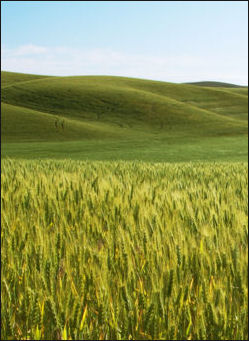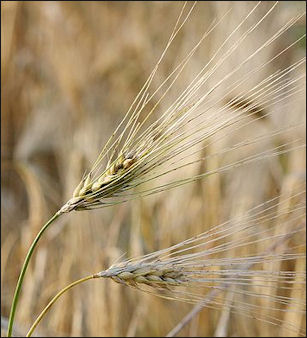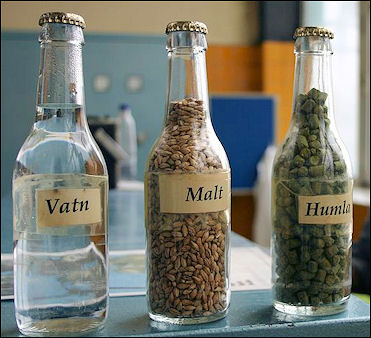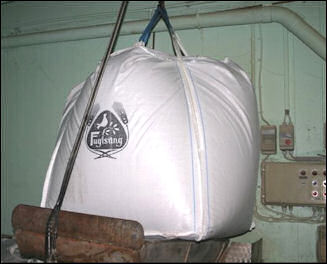BARLEY

Barley field Barley is a grain that is similar to wheat in appearance and is the only grain that grows well in the extreme north and in high altitudes. It can be found in Arctic regions and in the high Himalayas. Russia leads the world in barley productions (around 42 million tons a year).
Barley is rich is soluble fiber, which slows down digestion and helps lower cholesterol. It is rarely eaten in the West anymore because it regarded as coarse and is associated with peasant food.
Barley is made into black barley bread and sometimes served as a side dish. Traditionally barley has been a less important food source than other grains because it contains only small amounts of gluten, which is desirable when making bread. It is chiefly used as livestock feed, malt, thickening soups and modifying cow's milk for babies.
Websites and Resources: Barleyworld: barleyworld.org ; Wikipedia article Wikipedia ; World’s Healthiest Foods whfoods.com ; BarleyFood, org barleyfoods.org ; U.S. Grains Council grains.org/barley
History of Barley
Grains such as wheat, barley, oats and rye were originally steppe grasses. Emmer wheat, rye and barley were cultivated around the same time, and is difficult to say which was cultivated first. Emmer wheat and another wheat strain from the Caspian Sea are thought to be the first bread wheats. Emmer wheat is a wild grass. It is thought to have been singled out because its seeds stay attached to the stem significantly longer than that of other grasses.
Barley was first grown in the Jordan valley about 10,000 years ago. The earliest levels of excavations at Jericho indicate that the people that lived there collected seeds of cereal grass from rocky crags flanking the valley and planted them in the fertile alluvial soil. The technique of dating starch granules found in cracks in rocks used to grind up plant material have has been used to find the earliest known use of several foods, including 23,000-year-old barley discovered in Israel [Source: Ian Johnston, The Independent, July 3, 2017]
Wheat and barley agriculture spread out of Fertile crescent by 7000 B.C. By 6000 B.C., it had gotten as far as the Black Sea and present day Greece and Italy. By 5000 B.C. it had spread to most of southern Europe. The Linear Pottery Culture of central Hungary is believed to have introduced agriculture to central Europe around 5000 B.C. Agriculture finally reached southern Britain and Scandinavia around 3800 B.C. and north Britain and central Scandinavia by 2,500 B.C.
See Separate Articles: ORIGIN AND EARLY HISTORY OF AGRICULTURE factsanddetails.com FIRST GRAINS AND EARLIEST CROPS: BARLEY, EINKORN AND EMMER WHEAT, MILLET, SORGHUM, RICE AND CORN factsanddetails.com ; GRAINS factsanddetails.com
Barley Agriculture

Barley fruit Barley, wheat and rye bear their seeds in spikes. Barley is divided into the six-rowed type, four rowed-type and two-rowed type, based on the structure of the spikes. The six-rowed type has the highest yields. The four-rowed type are used in high altitudes and northern climates.
Barley needs well drained soils but does not thrive in sand. Because barley ripens in a relatively short period it can often be sown and harvested after wheat.
In highland areas such as Tibet, barley is cultivated on rocky terraces or hills. Sometimes plows are attached to yaks but most fields are hoed by hand with long-handled wooden spades. To ensure that the barley gets all the available water, weeds are pulled up and later eaten as food or given to animals. Some farmers also manage to grow turnips, radishes and cabbage.Harvesting is done by hand with sickles. Villagers help their neighbors during the harvest in return for help with their harvests. Those with no land trade labor for grain.
After harvesting barley is bundled and laid out in sheaves to dry. It is threshed with rakes and sticks. Eric Valli wrote in National Geographic, "The barley is prepared handful by handful as workers twist the tops of the stalks from the straw. Then the threshing begins as beaters face each other, the women in one row, men in the other. Singing to set the rhythm, each row of beaters wields wooden flails against the heads of barley on the hard packed ground. As the beaters tire, their song slows; it picks up as they revive.”
Barley is often winnowed in the wind by women. In the Dolpo region, the women whistle to call wind and gently tips their basket. Valli wrote, "A woman with a basket tosses threshed barley in the air; the chaff blows away and the seeds fall.” When most of the work is done in Dolpo, there is feast in the village with barley beer and music made from with five-string lutes and dancing around a fire.
World’s Main Barley Producing and Exporting Countries
World’s Top Producers of Barley (2020): 1) Russia: 20938993 tonnes; 2) Spain: 11465350 tonnes; 3) Germany: 10769200 tonnes; 4) Canada: 10740600 tonnes; 5) France: 10273570 tonnes; 6) Australia: 10127175 tonnes; 7) Turkey: 8300000 tonnes; 8) United Kingdom: 8117000 tonnes; 9) Ukraine: 7636340 tonnes; 10) Argentina: 4483062 tonnes; 11) Denmark: 4156500 tonnes; 12) Kazakhstan: 3659260 tonnes; 13) Iran: 3600000 tonnes; 14) United States: 3599510 tonnes; 15) Poland: 2944790 tonnes; 16) Ethiopia: 2261265 tonnes; 17) Syria: 2245791 tonnes; 18) Czechia: 1816180 tonnes; 19) Iraq: 1756200 tonnes; 20) India: 1720000 tonnes ; [Source: FAOSTAT, Food and Agriculture Organization (U.N.), fao.org. A tonne (or metric ton) is a metric unit of mass equivalent to 1,000 kilograms (kgs) or 2,204.6 pounds (lbs). A ton is an imperial unit of mass equivalent to 1,016.047 kg or 2,240 lbs.]
World’s Top Producers (in terms of value) of Barley (2019): 1) Russia: Int.$3991808,000; 2) France: Int.$2642897,000 ; 3) Germany: Int.$2258326,000 ; 4) Canada: Int.$2022801,000 ; 5) Ukraine: Int.$1737221,000 ; 6) Australia: Int.$1718160,000 ; 7) United Kingdom: Int.$1567960,000 ; 8) Spain: Int.$1508762,000 ; 9) Turkey: Int.$1480678,000 ; 10) Argentina: Int.$996973,000 ; 11) Kazakhstan: Int.$746197,000 ; 12) United States: Int.$719271,000 ; 13) Denmark: Int.$706159,000 ; 14) Iran: Int.$701374,000 ; 15) Poland: Int.$645180,000 ; 16) Syria: Int.$594828,000 ; 17) Ethiopia: Int.$463298,000 ; 18) Romania: Int.$366263,000 ; 19) Czechia: Int.$334723,000 ; 20) Finland: Int.$331586,000 ; [An international dollar (Int.$) buys a comparable amount of goods in the cited country that a U.S. dollar would buy in the United States.]

beer IngredientsTop barley-producing producing countries in 2008: (first, Production in $1000; second, Production, metric tons, FAO): 1) France, 869819 , 12171300; 2) Germany, 555426 , 11967114; 3) Australia, 548647 , 7996506; 4) Ukraine, 497808 , 12611500; 5) Russian Federation, 394278 , 23148450; 6) United States of America, 359017 , 5229590; 7) United Kingdom, 290611 , 6144000; 8) China, 281992 , 3100000; 9) Spain, 171513 , 11261100; 10) Argentina, 157877 , 1690085; 11) Ethiopia, 124543 , 1352148; 12) Turkey, 123894 , 5923000; 13) Czech Republic, 111011 , 2243865; 14) Denmark, 102351 , 3396000; 15) India, 96815 , 1196100; 16) Morocco, 80710 , 1353240; 17inland, 75477 , 2128600; 18) Poland, 75229 , 3619460; 19) Hungary, 74524 , 1467055; 20) Kazakhstan, 72901 , 2058550;
World’s Top Exporters of Barley (2020): 1) France: 6778158 tonnes; 2) Ukraine: 5046350 tonnes; 3) Russia: 4963402 tonnes; 4) Australia: 4258209 tonnes; 5) Canada: 2807251 tonnes; 6) Germany: 2405178 tonnes; 7) Argentina: 2233130 tonnes; 8) United Kingdom: 1574932 tonnes; 9) Romania: 1309028 tonnes; 10) Kazakhstan: 980295 tonnes; 11) Hungary: 831605 tonnes; 12) Denmark: 717795 tonnes; 13) Sweden: 421677 tonnes; 14) Syria: 401701 tonnes; 15) Lithuania: 383855 tonnes; 16) Czechia: 354391 tonnes; 17) Bulgaria: 333032 tonnes; 18) Poland: 301479 tonnes; 19) Estonia: 291141 tonnes; 20) United States: 187077 tonnes
World’s Top Exporters (in value terms) of Barley (2020): 1) France: US$1359114,000; 2) Australia: US$908420,000; 3) Russia: US$898888,000; 4) Ukraine: US$877563,000; 5) Canada: US$600761,000; 6) Germany: US$480207,000; 7) Argentina: US$457326,000; 8) United Kingdom: US$305973,000; 9) Romania: US$244845,000; 10) Kazakhstan: US$176172,000; 11) Denmark: US$155693,000; 12) Hungary: US$140153,000; 13) Sweden: US$86106,000; 14) Lithuania: US$73468,000; 15) Czechia: US$68127,000; 16) Bulgaria: US$65436,000; 17) Syria: US$56345,000; 18) Poland: US$56279,000; 19) Estonia: US$55446,000; 20) United States: US$47156,000
Pearled barley, or pearl barley, is barley that has been processed to remove its fibrous outer hull and polished to remove some or all of the bran layer.World’s Top Exporters of Pearled Barley (2020): 1) Belgium: Pearled Barley: 16411 tonnes; 2) Netherlands: 8455 tonnes; 3) Germany: 4129 tonnes; 4) Russia: 3721 tonnes; 5) United Kingdom: 1501 tonnes; 6) Denmark: 1237 tonnes; 7) Latvia: 940 tonnes; 8) Italy: 732 tonnes; 9) Czechia: 655 tonnes; 10) United States: 423 tonnes; 11) Austria: 364 tonnes; 12) France: 338 tonnes; 13) Spain: 270 tonnes; 14) Croatia: 110 tonnes; 15) Portugal: 105 tonnes; 16) Slovakia: 84 tonnes; 17) New Zealand: 67 tonnes; 18) Hong Kong: 47 tonnes; 19) Hungary: 35 tonnes; 20) Poland: 29 tonnes
World’s Top Exporters (in value terms) of Pearled Barley (2020): 1) Netherlands: US$4645,000; 2) Belgium: US$4345,000; 3) Germany: US$2550,000; 4) Russia: US$1291,000; 5) Denmark: US$986,000; 6) United Kingdom: US$746,000; 7) Italy: US$726,000; 8) Portugal: US$393,000; 9) France: US$355,000; 10) Latvia: US$346,000; 11) United States: US$308,000; 12) Austria: US$282,000; 13) Czechia: US$201,000; 14) Spain: US$145,000; 15) Hong Kong: US$110,000; 16) Slovakia: US$105,000; 17) New Zealand: US$70,000; 18) Hungary: US$66,000; 19) Egypt: US$47,000; 20) Poland: US$38,000
Malt

large bag of beer malt Malt is barley or another grain that has been artificially germinated or sprouted by moisture and heat. Traditionally, it was made by steeping the grain in cisterns from 48 to 100 hours at a temperature of about 55̊F, then spread on a floor to germinate, and then dried.
During the malting process various enzymes are produced by fermentation. One of the most important is “diastase” , which has the ability to change starch into sugar. Maltose is a kind of sugar produced from starch by malting with diastase.
Malt is used in brewing beers, making malted milks and baby food (the malting process has the same effect as partial digestion). See Beer
World’s Top Importers of Malt (2019): 1) Brazil: 1091558 tonnes; 2) Mexico: 572799 tonnes; 3) Japan: 496353 tonnes; 4) Belgium: 445792 tonnes; 5) United States: 438777 tonnes; 6) Netherlands: 293203 tonnes; 7) Vietnam: 292077 tonnes; 8) Germany: 231576 tonnes; 9) Thailand: 214040 tonnes; 10) Poland: 200977 tonnes; 11) Nigeria: 190623 tonnes; 12) Philippines: 182165 tonnes; 13) South Korea: 169870 tonnes; 14) Cambodia: 158152 tonnes; 15) Italy: 148771 tonnes; 16) South Africa: 97073 tonnes; 17) Cameroon: 89744 tonnes; 18) Angola: 87961 tonnes; 19) Russia: 83764 tonnes; 20) Romania: 79859 tonnes [Source: FAOSTAT, Food and Agriculture Organization (U.N.), fao.org]
World’s Top Importers (in value terms) of Malt (2019): 1) Brazil: US$543581,000; 2) Mexico: US$326716,000; 3) United States: US$306758,000; 4) Japan: US$280879,000; 5) Vietnam: US$197901,000; 6) Belgium: US$167478,000; 7) Netherlands: US$113027,000; 8) Thailand: US$102228,000; 9) Germany: US$97088,000; 10) Philippines: US$92803,000; 11) South Korea: US$91643,000; 12) Nigeria: US$87423,000; 13) Poland: US$86363,000; 14) Cambodia: US$83656,000; 15) Italy: US$75045,000; 16) Angola: US$67662,000; 17) South Africa: US$45330,000; 18) Cameroon: US$42532,000; 19) Russia: US$39738,000; 20) Romania: US$38184,000
Image Sources: Wikimedia Commons
Text Sources: National Geographic, New York Times, Washington Post, Los Angeles Times, Smithsonian magazine, Natural History magazine, Discover magazine, Times of London, The New Yorker, Time, Newsweek, Reuters, AP, AFP, Lonely Planet Guides, Compton’s Encyclopedia and various books and other publications.
Last updated March 2022
